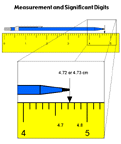

|
1.10 x 104
|
|
11000 | and has 3 significant digits. |
|
1.1 x 104
|
|
11000 | and has 2 significant digits. |
|
1.1000 x 104
|
|
11000 | and has 5 significant digits. |
|
|
|
|
|
|
|
|
|
|
|
|
|
|
|
|
|
|
|
|
The numbers which are in bold are definitely significant. The green numbers may or may not be significant depending on how the measurement was made.
|
|
|
|
|
|
|
|
|
|
|
|
|
|
|
|
|
|
|
|